by Winding Pathways | Jun 24, 2021 | (Sub)Urban Homesteading, Amphibians/Reptiles, Garden/Yard, Nature
Guest Blog by Leslie Wright
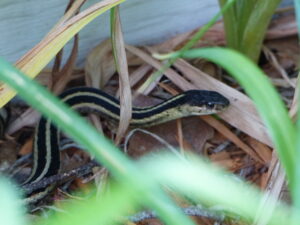
Garter snakes like cool, shady places to wait for a meal.
Just over a year and a half ago, we moved from a home with a suburban postage-stamp-sized yard with little wildlife into a home with a large yard that backs up to a sizable park. Each season we have discovered something new about our new urban “wilderness”. Last spring it was how to identify (and avoid) poison ivy. This spring the theme seems to be reptiles! Earlier this spring I became acquainted with our resident garter snake. Most often it spent time in our vegetable garden but occasionally sunned itself near where I was working in the yard. Though I am not comfortable around snakes I was glad to see him/her – to me a symbol of more abundant life.
How the Adventure Began
Thursday, May 6th seemed like any other lovely spring day. I took myself outside to walk around the gardens and see what was coming up. I walked around to the front of the house to check on hydrangeas I had planted last spring. I had wrapped them in bird netting last year thinking to keep deer from nibbling the tender shoots. To my dismay, I discovered that our resident garter snake had become entangled in the netting, and even worse a much larger snake had also found its way into netting nearby. To my uneducated eyes, this snake looked like a small rattlesnake with a brownish diamond pattern. I was almost relieved that it appeared to be dead. But I knew I needed to rescue my garter snake friend. I was afraid to do this myself – afraid of getting bitten mostly.
So, I started to call and text everyone I could think of to rescue this snake – and me! My husband who was in a meeting, the nature center, DNR. But, alas, I soon figured out I was going to have to tackle this myself if I wanted the snake to survive. So off to Google I went.
Google To The Rescue!
The snakes had netting in their mouths and wrapped around their bodies, multiple times. Google informed me I would need to gently restrain the snake and use nail scissors to cut it free. So, I put on gardening gloves, found a stick with a small fork to hold the snake’s head, and armed myself with nail scissors. Probably more to calm myself, I talked to my little friend while I cut away the netting. Success! After I freed the garter snake I went inside for a moment.
-
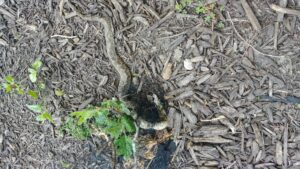
-
Netting gets caught in the snake’s scales when it tries to back out of the netting.
-
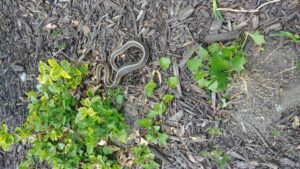
-
This snake slithered off when freed.
Rounds Two and Three
When I came back out – no lie – he/she had found its way into another piece of netting. So, round two – gloves, stick, and scissors. It was clear I needed to remove every shred of that darn bird netting to make sure it would not harm any other creatures. As I was clearing away the netting, I discovered the second snake was in fact alive. Now I had to save it, too! So round three – gloves, stick, and scissors, and the second snake was free. I later learned this is a fox snake.
All Is Well That Ends Well
I haven’t seen them since but I surely hope they are safe, well, and still visiting our yard.
by Winding Pathways | Jun 3, 2021 | Birds, Nature
Report from the Montessori School duck hatch: To review, the school saw a mallard sitting on an urban planter box. So, the staff and children made a project of watching the duck, noting its behavior, drawing pictures, and journaling about this experience. When the ducklings hatched the children, parents and staff followed the mother duck and ducklings on their way to new adventures.
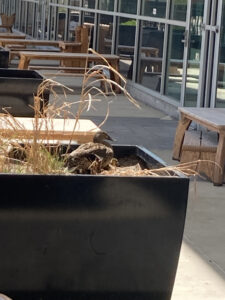
The Montessori children watched as the mallard duck sat on and hatched eggs
“The ducklings hatched last Sunday. On Monday, all 11 made it out of the planter and to the river. It was a bit traumatic. 10 fell into the storm drain and were brought out with a bug net by a parent.”
Some resources and thoughts:
The Wildlife Center of Virginia
Reconnect With Nature
Ducks Unlimited
by Winding Pathways | May 20, 2021 | Nature, Trees
May’s first few weeks are the most delightful time to be outdoors. Warm days combine with the delicious scent of spring. It’s the peak time for birds that wintered far to the south to either settle in to nest or briefly rest and eat before winging further north. Their songs fill the air.
Early May awakens plants, and in early May Rich discovered a treasure. It was an oak sprout that seemed to have “hope” written all over its new soft green leaves.
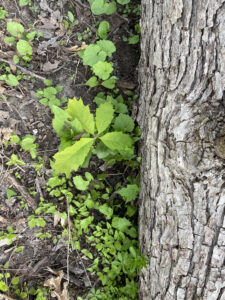
The seedling radiated hope.
Winding Pathways adjoins Faulkes Heritage Woods, an area of sloping land bordered by homes on the south and Indian Creek to the north. Last August 10th a derecho bearing 140 miles an hour wind tore through Iowa. Neither Winding Pathways nor Faulkes Woods was spared. Trees, many of them enormous, either snapped off or uprooted, leaving a scene many called “devastation.”
At first, that seemed like an apt description, and the woods looked ravaged all winter. Rebirth comes with spring. While sitting on a fallen log Rich looked down to see a tiny white oak sprout. It just seemed to say, “Hi, here I am ready to grow.”
Oaks thrive on sunshine, and with big trees now felled on the ground, light floods the soil to energize the leaves of the baby oak and other seedlings. Gradually the old tree will decompose. Its wood will add nutrients to the soil to be appreciated by the youngsters.
Nature has amazing resiliency. One just needs to look to see it.
by Marion Patterson | May 13, 2021 | Birds, Nature
In mid-April, we got a call from a concerned Montessori teacher. Her school is in downtown Cedar Rapids amid office buildings, restaurants, and taverns. Cars constantly buzz by.
She’d spotted a hen mallard duck nesting in the school’s playground and asked what she could do to help it. She knew what a great teaching opportunity this was. Children and teachers have spent the past several weeks observing and documenting the mama Mallard. They even named her – Mallory. Her partner is dubbed Howard.
Over the years we’ve fielded many similar calls from people in urban areas spotting nesting mallards and Canada geese.
For years people have heard that transforming natural areas to cities and suburbs destroys wildlife habitat. It does, at least for wildlife that shun people. However, many wild animals increase as an area urbanizes. House sparrows, rats, and pigeons come to mind, but some other beneficiaries are more welcome.
Cedar Rapids is bisected by the Cedar River, and many ducks nest downtown. Often a hen duck will nest in a large raised concrete flower pot, or as the Montessori School discovered, in the kids’ playground.
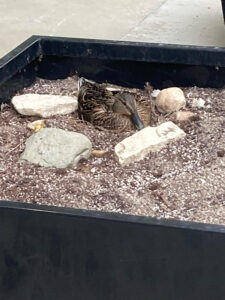
This female mallard is quite at home near the Montessori school.
Although this may seem odd, a city may be the safest nesting place. Mallards nest on the ground. Raccoons, dogs, opossums, and a slew of other predators love dining on eggs. Most duck nests out in the country get predated. All that’s left after a raccoon raid is eggshells. Fortunately, many waterfowl species renest, and usually enough nests are successful to maintain the population.
It may be that a nest in a raised concrete flower pot reduces the odds of a raccoon raid.
For many years a duck nested under a shrub near the front door of Washington High School. The hundreds of students who passed by the nest may have discouraged predators.
Canada geese also aren’t shy about people, factories, railroads, or even Interstate Highways. Many nest along Cedar Lake in an industrial area of Cedar Rapids. Normally they hide their nest, but we found one goose nesting immediately adjacent to a busy trail in plain sight.
This bird is now so numerous in many cities that they’re considered a nuisance, although we love seeing and hearing them.
So, what should someone do if they find a nesting duck or goose in a seemingly unlikely and unsafe place? The answer is simple. Just like the Montessori classes, Leave it alone, take photos, and enjoy having a beautiful and interesting animal make its home near people.
by Winding Pathways | Apr 1, 2021 | (Sub)Urban Homesteading, Garden/Yard, Garden/Yard, Nature
Winter Wanderers
We’ve been having more adventures with possums. Marion spotted a new visitor to the bird feeder one late February afternoon.
It was a smallish opossum. We called him “Pogo” after one of our favorite cartoon characters but didn’t realize we’d be playing tag with him (or her) for the next few weeks.
Pogo’s Feet
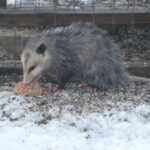
Possums’ feet help it hold food and climb.
Many people dislike possums and think they’re ugly and dumb. We like ‘em. They’re fascinating and love to eat ticks, including those that spread Lyme Disease. We find their paws especially interesting. Take a look at Pogo’s feet in the photos. They’re like strong-clawed hands that let him climb.
We spotted Pogo a few evenings later sniffing around our composter. He ambled off and scooted under a brush pile, where we assume he lived. That’s a fine place for an opossum to live so we left a scoop of dog food nearby for a late-night snack.
The next night Rich went out after dark to check the chickens in the barn. He turned on the light and there, staring at him from inside, was Pogo. Now, we like possums but not when they’re in the barn near the chickens.
Quite Comfortable
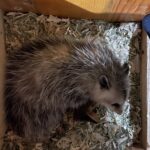
After eating an egg, Pogo took a nap.
I wondered, how in the world did he get in? We searched high and low for holes in the building big enough for a smallish opossum to squeeze through. There weren’t any, so we assumed he probably scooted in the open door during the day unseen. Rich ushered him out.
We didn’t see Pogo after that for a few days until Rich went out to gather eggs. There was Pogo napping in a nest! Our possum never seemed aggressive. He didn’t growl, snarl, or attempt to bite the shovel Rich used to scoot him out the door. He just opened his toothy mouth, stared at Rich as if to say, “What’s the problem?” and ambled to the brush pile. Again, we looked for possible openings and didn’t find any.
Quite at Home
No sign of Pogo for two more days. Then it was coop spring cleaning time. The chicken’s waterer was perched on two cinder blocks. Rich removed the waterer and went to pick up a cinder block when he saw a nose pointing out. There sat Pogo, curled up snugly inside one of the block’s cavities.
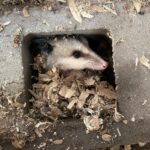
Opossum curled up in cinder block nest.
Again, all he did was stare and open his mouth as Rich explained that he was welcome to live under the brush pile but not in the barn.
We think we have the mystery solved. Pogo didn’t come into the barn after dark. He walked right through the chicken’s pop hole door when it was open during the day and made a home in the cinder block. It’s a great possum spot. He slept on soft wood chips and had plenty of fresh water and chicken feed nearby. Pogo probably snacked on an egg or two but never attempted to catch or kill a chicken.
We still want him to live in the brush pile but not in the barn. So, we now carefully monitor every nook and cranny in the barn before we lock the door at night. We haven’t seen Pogo in the coop lately and hope he’s relocated permanently to the brush pile.
by Winding Pathways | Mar 25, 2021 | Amphibians/Reptiles, Birds, Bugs, Nature, Trees, Wonderment
Quilting and the Chesapeake Bay
Guest Blogger, Sigrid Reynolds
I have always loved the humble arts of unknown women who pieced quilts. My own attempts at the craft had resulted in exactly 10 squares in the 1980s when I had small children at home who took afternoon naps. At the same time, I started looking through the piles of quilts at antique stores in the Shenandoah Valley. It thrilled me to see the patterns, colors, and precise stitching of women from the past. So seduced was I by these piles, I knew collecting could get out of control. But then I found a Pennsylvania Dutch unquilted top in an original bold tulip design of blue, red, and yellow colors. I decided to seek and purchase only this color combination. That kept the lid on it since these colors are rare in combination.
COVID-19 Quilting
Taking up quilting again didn’t occur to me until Spring 2020 when I was asked to join a young friend’s virtual pandemic quilt circle. In a time when we all faced our own mortality and the uncertain path the pandemic and the nation would take, we needed something to calm ourselves. As a retired person, I had nothing filling my time and frankly, felt the need to leave some little part of me behind in the lives of my descendants.
The group chose a striking geometric pattern with many triangular pieces. I purchased material, cut a few triangles, and then I went rogue. My inclination was to go faster, larger and more personal since I’d found piecing tedious in those earlier tries. Besides, I am 30 years older than the members in my group so my “life” time is more limited. I found purpose in a multi-generational family vacation home on the Chesapeake Bay just begging for Aunt Sig artifacts for posterity.
A “Fishy” Quilting Inspiration
My first quilt was a re-interpretation of a fish painting that the family had owned for 90 years. The family has always asked guests to tell them how many fish they see in the painting. So, I added goldfish for a humorous twist and quilted in additional fish. In all, there are 40 fish in this quilt.
-
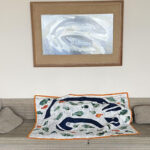
-
A humorous adaptation of the family fish painting.
-
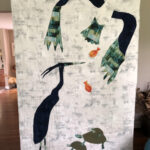
-
Remembering sunning turtles.
What came next was an urge to recognize the other birds and animals seen regularly on or near the Bay: herons in the morning and evening along with osprey all day. And then I was remembering sunning turtles in a nearby spring-fed pond. I added more goldfish and quilt fish to keep the puzzle going.
I next needed to represent the loblolly pines that line the shores of that estuary. And, of course, I needed additional visitors: raccoons, foxes, and box turtles. While quilting, I added one ghostly possum in the lower right-hand corner. And why not add some quilted poison ivy since that is always an island hazard? And yes, there are fish quilted into the water to count.
-
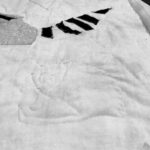
-
The beginnings of a personal quilt.
-
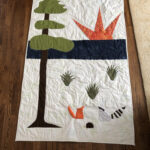
-
Capturing the sunrise
New Inspirations
Finally, as this quiet, worrisome time comes to an end, I realized that I needed to turn from nature to hail the Baltimore Light, a caisson lighthouse, that has defined the deep channel for ships going into Baltimore Harbor my entire life. Since it was winter, I recalled the two times that I had seen the Bay had frozen and decided that might be a good subject. And yes, there will be quilted fish to count under the ice floes.
Nature Continues to Inspire
I have pondered what prompts this late-in-life creativity and conclude that the pandemic opened up a fertile field in me that might have remained fallow. I, like many, turned to the nearby nature of our backyard and parks but memories of a barefoot childhood on the Bay persisted. Quilting allowed me to visit the nature of my memories.















